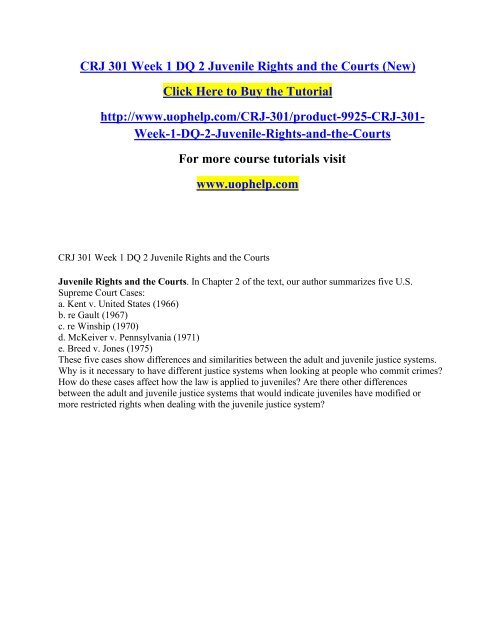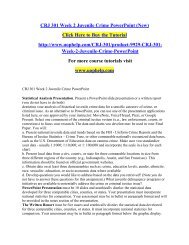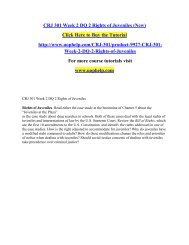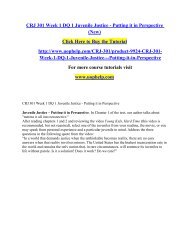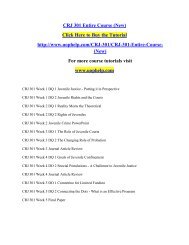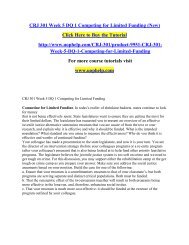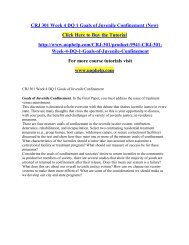CRJ 301 Week 1 DQ 2 Juvenile Rights and the Courts (New).
For more course tutorials visit www.uophelp.com CRJ 301 Week 1 DQ 2 Juvenile Rights and the Courts Juvenile Rights and the Courts. In Chapter 2 of the text, our author summarizes five U.S. Supreme Court Cases: a. Kent v. United States (1966) b. re Gault (1967) c. re Winship (1970) d. McKeiver v. Pennsylvania (1971) e. Breed v. Jones (1975) These five cases show differences and similarities between the adult and juvenile justice systems. Why is it necessary to have different justice systems when looking at people who commit crimes? How do these cases affect how the law is applied to juveniles? Are there other differences between the adult and juvenile justice systems that would indicate juveniles have modified or more restricted rights when dealing with the juvenile justice system?
For more course tutorials visit
www.uophelp.com
CRJ 301 Week 1 DQ 2 Juvenile Rights and the Courts
Juvenile Rights and the Courts. In Chapter 2 of the text, our author summarizes five U.S. Supreme Court Cases:
a. Kent v. United States (1966)
b. re Gault (1967)
c. re Winship (1970)
d. McKeiver v. Pennsylvania (1971)
e. Breed v. Jones (1975)
These five cases show differences and similarities between the adult and juvenile justice systems. Why is it necessary to have different justice systems when looking at people who commit crimes? How do these cases affect how the law is applied to juveniles? Are there other differences between the adult and juvenile justice systems that would indicate juveniles have modified or more restricted rights when dealing with the juvenile justice system?
- No tags were found...
You also want an ePaper? Increase the reach of your titles
YUMPU automatically turns print PDFs into web optimized ePapers that Google loves.
<strong>CRJ</strong> <strong>301</strong> <strong>Week</strong> 1 <strong>DQ</strong> 2 <strong>Juvenile</strong> <strong>Rights</strong> <strong>and</strong> <strong>the</strong> <strong>Courts</strong> (<strong>New</strong>)<br />
Click Here to Buy <strong>the</strong> Tutorial<br />
http://www.uophelp.com/<strong>CRJ</strong>-<strong>301</strong>/product-9925-<strong>CRJ</strong>-<strong>301</strong>-<br />
<strong>Week</strong>-1-<strong>DQ</strong>-2-<strong>Juvenile</strong>-<strong>Rights</strong>-<strong>and</strong>-<strong>the</strong>-<strong>Courts</strong><br />
For more course tutorials visit<br />
www.uophelp.com<br />
<strong>CRJ</strong> <strong>301</strong> <strong>Week</strong> 1 <strong>DQ</strong> 2 <strong>Juvenile</strong> <strong>Rights</strong> <strong>and</strong> <strong>the</strong> <strong>Courts</strong><br />
<strong>Juvenile</strong> <strong>Rights</strong> <strong>and</strong> <strong>the</strong> <strong>Courts</strong>. In Chapter 2 of <strong>the</strong> text, our author summarizes five U.S.<br />
Supreme Court Cases:<br />
a. Kent v. United States (1966)<br />
b. re Gault (1967)<br />
c. re Winship (1970)<br />
d. McKeiver v. Pennsylvania (1971)<br />
e. Breed v. Jones (1975)<br />
These five cases show differences <strong>and</strong> similarities between <strong>the</strong> adult <strong>and</strong> juvenile justice systems.<br />
Why is it necessary to have different justice systems when looking at people who commit crimes?<br />
How do <strong>the</strong>se cases affect how <strong>the</strong> law is applied to juveniles? Are <strong>the</strong>re o<strong>the</strong>r differences<br />
between <strong>the</strong> adult <strong>and</strong> juvenile justice systems that would indicate juveniles have modified or<br />
more restricted rights when dealing with <strong>the</strong> juvenile justice system?


